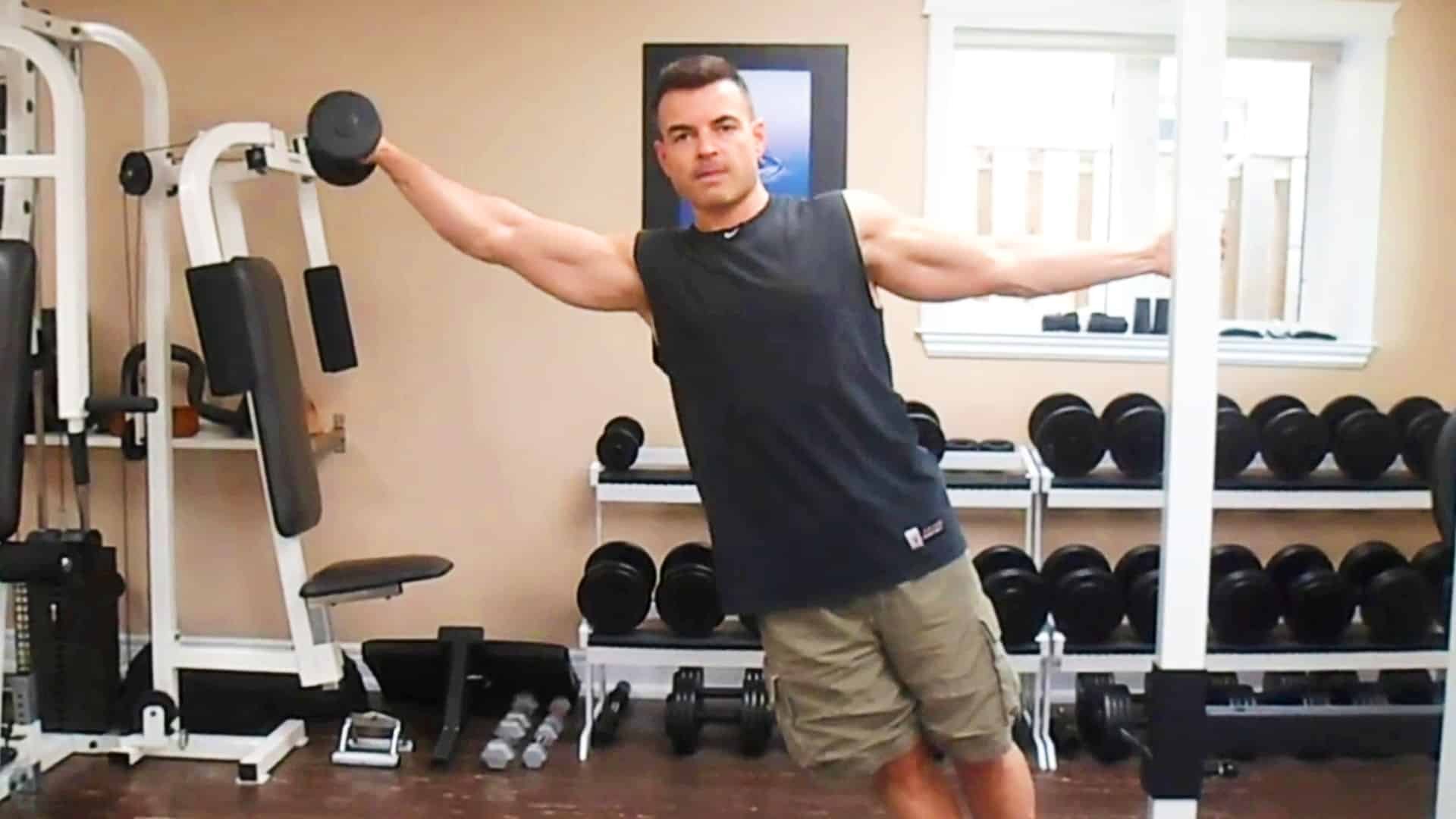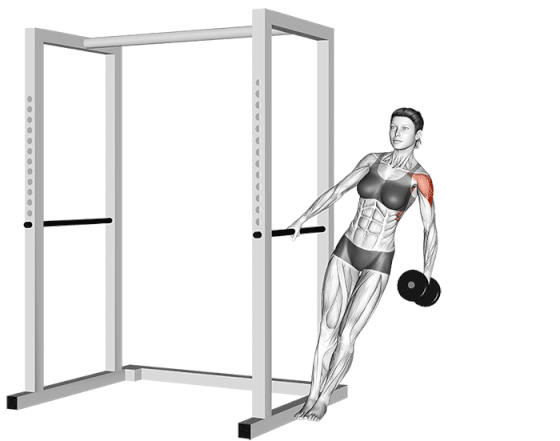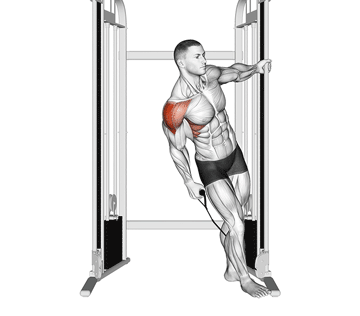The leaning lateral raise, also called the leaning dumbbell raise, is a variation of the standard dumbbell lateral raise that provides a more challenging yet effective workout for strengthening the shoulders.
To build the lateral head of the deltoid muscle, include a leaning dumbbell lateral raise in your deltoid exercises.
Compared with the dumbbell lateral raise, the leaning away lateral raise puts your lateral deltoid under tension through a greater portion of the range of motion. It offers a deeper stretch and more intense contraction of the deltoid muscles.
The leaning position creates leverage while maximizing the isolation of the shoulders throughout the movement. It also places greater overload at the top of the movement.

- Leaning Lateral Raise Muscles Worked
- How To Do Leaning Dumbbell Lateral Raise
- Tips and Form
- Variations of Leaning Lateral Raises
- 1. Leaning Cable Lateral Raise
- 2. Resistance Band Leaning Lateral Raise
- Benefits of the Leaning Lateral Raise
- Leaning Lateral Raise Alternatives
- FAQs
- How many lateral raises should I do
- Leaning lateral raise vs lateral raise
- Know More About Shoulder Training
Leaning Lateral Raise Muscles Worked
- The primary Muscle Worked: lateral deltoid (middle portion of the deltoid muscle).
- Secondary Muscle Worked: The anterior deltoid, posterior deltoid, upper trap, supraspinatus (a rotator cuff muscle), and serratus anterior (muscles along your ribs under your armpit)
- A handful of other muscles worked or play the role of stabilizer muscles, including your: Wrist flexors, Obliques, and Rectus abdominis.

How To Do Leaning Dumbbell Lateral Raise
- Find a bench or a sturdy surface you can lean against. This could be a cable machine or even a squat rack.
- Grab a dumbbell in one hand and grasp the pole with the other hand.
- With your feet together, lean away from the wall or rack. Your torso should be at an angle.
- Lift the dumbbell out to the side, bringing it to shoulder height.
- When you reach the top, hold for a while and then slowly lower the dumbbell back to where you started.
- Perform the desired number of repetitions, typically between 8 to 15, then switch to the other side and repeat.

Tips and Form
- When leaning forward, your torso should be angled at about 30 to 45 degrees. This angle reduces the involvement of the traps and focuses more on the lateral deltoids.
- Maintain a neutral spine throughout the movement to avoid excessive strain on your lower back.
- Keep a slight bend in your elbow (about 10-15 degrees).
- Keep your body still; only your arm should move.
- Keep a controlled motion and avoid jerky movements.
- If you have to swing the dumbbell, you should reduce the load because you are using too much weight.
- Do not allow the handle to touch your body, and do not allow your body to move (or swing) throughout the movement.
- Breathe steadily, typically exhaling on the lifting phase and inhaling on the lowering phase.
- Experiment with hand position (thumb up, neutral, or thumb down) to find what feels most comfortable for your shoulder.
Variations of Leaning Lateral Raises
There are several ways to do the leaning lateral raise that will keep your workouts productive and exciting.
1. Leaning Cable Lateral Raise
Unlike dumbbells, where gravity is your only source of resistance, cables provide constant tension throughout the entire range of motion. This means your deltoids are engaged from the start of the lift until the end.
The amount of muscle stretched during exercise directly depends on muscle growth and strength gains, so cable machines tire the muscles faster and provide greater strength gain.

How To Do
- Stand next to a cable pulley machine with the handle attachment adjusted to the lowest.
- With the outside arm, reach across your body, grab the handle and stand straight up with your arm fully extended and feet facing forward.
- Grip the machine with your inside arm for support. Position your feet close to the pulley machine, allowing you to lean away from it.
- Maintain a slight bend in your working elbow, and raise your arm up to shoulder height.
- Then, lower the weight back to the starting position.
- Repeat for the desired number of repetitions and repeat on the other side.
Know More: Cable Lateral Raises: How To Do, Muscle Worked & Alternates
2. Resistance Band Leaning Lateral Raise
The resistance band leaning lateral raise is a noteworthy variation of the lateral raise that can be performed with bands in the comfort of your home.
One of the best things about resistance bands is their portability. You can easily pack them in your gym bag or take them on the go. Whether you’re traveling or working out at home, you’ll always have a versatile tool for a great shoulder workout.
How to Do
- Anchor the band or stand in the loop.
- Lean torso forward from hips. Engage core.
- Keep a slight bend in your elbows, and raise your arms to the sides until they parallel the floor.
- Slowly return to the start position in controlled motion.
- Control movement on both eccentric and concentric.
Benefits of the Leaning Lateral Raise
Here are some potential benefits of the leaning lateral raise to build muscle and strength.
- The Leaning Lateral Raise targets the lateral deltoids. It improves your upper body strength and appearance.
- This exercise is performed while leaning sideways, which requires the core muscles to engage to maintain stability.
- Strong deltoids are particularly beneficial for athletes who require upper body strength and stability for their sport.
- Strengthening the shoulders, back, and core can improve performance in sports like volleyball, basketball, and swimming.
- It is a unique exercise that can add variety to your workout routine. Mixing up your exercises can challenge your body in new ways and prevent boredom or plateaus in your progress.
Leaning Lateral Raise Alternatives
Here’s an alternative exercise to the leaning lateral raise:
- Dumbbell one-arm lateral raise
- Cable Lateral Raise
- Arnold Shoulder Press
- Landmine Lateral Raise
- Y Raise
FAQs
How many lateral raises should I do
It’s recommended to perform 3–4 sets of 8–12 repetitions of lateral raises with a weight that allows you to complete each set with good form and without excessive strain or fatigue.
Leaning lateral raise vs lateral raise
The leaning lateral raise is performed by leaning forward at the hips, holding a weight in one hand, and lifting the weight out to the side.
The opposite arm is placed on a bench or supports to maintain stability. This exercise engages the core muscles and uniquely challenges the lateral deltoids.
On the other hand, the Lateral raise is performed while standing upright, holding a weight in each hand or in one hand.
Know More About Shoulder Training
- Best Dumbbell Shoulder Exercises & Workouts For Mass
- Best Cable Shoulder Workout & Exercises for 3D Deltoids
- One Arm Cable Lateral Raise: How To Do & Muscle Worked
- Dumbbell Shoulder Fly: Muscles Worked, Benefits, Tips
- Different Shoulder Exercises Affect the Activation of Deltoid Portions in Resistance-Trained Individuals

Manish is a NASM-certified fitness and nutrition coach with over 10 years of experience in weight lifting and fat loss fitness coaching. He specializes in gym-based training and has a lot of knowledge about exercise, lifting technique, biomechanics, and more.
Through “Fit Life Regime,” he generously shares the insights he’s gained over a decade in the field. His goal is to equip others with the knowledge to start their own fitness journey.
